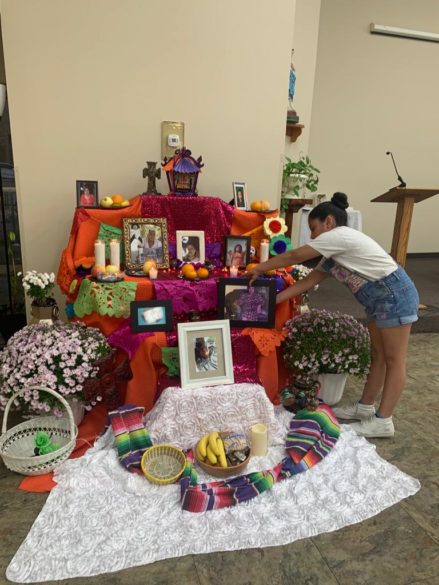By Berta Mexidor
JACKSON – Several parishes around the diocese are dedicated to erecting altars for the Day of the Dead – Día de los Muertos. For many it is important to pass on the knowledge of the meaning behind the altar creation.
At Immaculate Heart of Mary in Houston, the history of honoring deceased family members and friends with an altar is a tradition parishioners look forward to.
Lay ecclesial minister, Danna Johnson says that “it is beautiful how families pass this tradition to the new generations.”
Johnson recently witnessed a parishioner bring in her young daughter Delayza to place an offering in front of the photo of the late Timotea, her mother and grandmother, respectively.
Rosalinda and Joel Montoya of St. Therese parish in Jackson work to pass the tradition down to the young people of the parish, giving them instructions and build the altar each year. The hope is that the tradition will continue for years to come.
At St. James Tupelo, Rosario González and Gricelda Martinez took on the task of making the altar this year. Each of the colorful altars has the tradition of being created from two to seven stages, as Martinez explains, which represent the steps that souls take to the final rest or the seven original sins, depending on the elder traditions. Martinez also explains that altars can be made up of just three levels, which would represent heaven, earth and the underworld.
From family and friends, each altar receives the offering of products representing the four elements: earth, wind, fire and water. Each stage of the altar and what to be placed on each has a meaning, as well as each of the elements used for decorations.
Photos – Photos of the deceased are always placed on the altar. The inclusion of mirrors is optional, according to each tradition.

Arches – Symbolize the entrance to the world of the dead
Papel “Picado” (Tissue paper flags) – Represent the festive joy of the day and the movement of the wind.
Water – A glass of water is placed for the purity of the soul and the regeneration of life.
Seeds – Represent the element of earth.
Cempasuchitl flowers – Flor de Muerto (Flower of the Dead) or marigolds have an aroma that guides the spirits on their journey to this world.
Copal Incense – This is used to drive away evil spirits.
Candles – They light the path of the souls of the deceased.
Calacas-catrinas (skulls): They allude to death and can be made with sugar or any material.
Saints – The altar is always accompanied by images of Jesus and other saints of devotion.
Salt – A symbol of the purification of the spirits.
Food and drink – Favorite dishes or drinks of the deceased.
Pan de Muerto (Bread of Death) – The bread is circular in shape to represent the constant cycle between life and death. It is decorated with four small cross-shaped loaves for each one of the cardinal points, connected with a round roll at the top, that represents the skull of a skeleton.
Cross – It is always placed on the top of the altar or formed with seeds, fruits, salt, ashes or cempasuchil flowers.
The celebration of the Day of the Dead is already traveling from churches, the land of Mexico and cemeteries to become a popular celebration in offices, parks, museums and other such spaces. An altar can always be set up for family and friends to share photos, stories and memories of the people who have departed.
Día de los Muertos celebrations traditionally begin on Oct. 31, coinciding with Halloween, and continue through All Saints Day and All Souls Day – but everything does not end on Nov. 2. Sometimes, a closing ritual of the altar is performed on Nov. 3.
Jose, from station 97.5 in Los Angeles explains that, according to tradition, many the next day light a “white candle, burn copal’s incense and say goodbye to the souls…” of the deceased who attended their celebration, and they are asked to come back next year. “After this ritual, the offering is raised,” he concludes.
